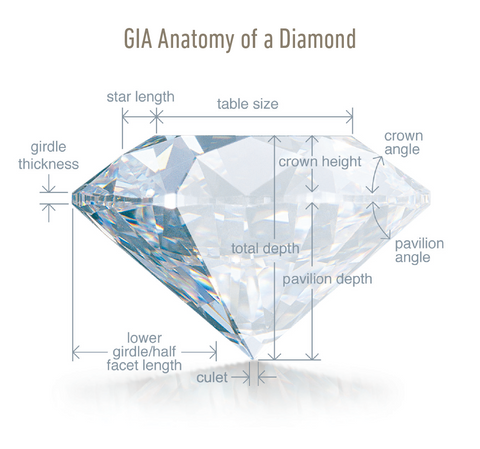The Anatomy of a Diamond
The Anatomy of a Diamond
- Table: The table is the top horizontal facet of the diamond. The table size is expressed as a percentage of the diamond’s average girdle diameter. An ‘Excellent’ grade diamond table size will be between 52 and 62 percent.
- Crown Angle: This is the angle that’s formed where the bezel facets meet the girdle. A well cut diamond will have an angle between 31.5 to 36.5 degrees. The crown angle will have an effect on the appearance of a round brilliant cut diamond.
- Crown Height: This measures the upper portion of the diamond, from the top edge of the girdle to the table can affect both the dispersion and brightness of a diamond.
- Lower Girdle / Half Facet Length: This ratio calculates how long the lower girdle facets are relative to the length of the pavilion. A well cut diamond will range between 65 to 90 percent and controls the brilliance of a diamond. Diamonds with longer lower half facets will have slightly more scintillation.
- Girdle Thickness: The girdle is the middle portion of a diamond separating the crown from the pavilion. The girdle thickness is described as a range from its thinnest to thickest areas. A girdle that is “medium to slightly thick” is preferred over a thick or an extremely thin girdle.
- Pavilion Angle: Pavilion angle relates to a diamond’s brightness. This is the average of the angles formed by the diamond’s pavilion main facets and its girdle plane. To rate an Excellent grading it should fall between 40.6 and 41.8 degrees providing other parameters also fit their proper ranges.
- Pavilion Depth: The pavilion is the lower portion of a diamond from the bottom edge of the girdle to the culet. The depth is conveyed as a percentage of the average girdle diameter. A too shallow or too deep pavilion depth allows light to escape from the side or bottom of the stone rather than upward through the crown.
- Culet: The culet is the small facet at the bottom of a diamond. The size of the facet is expressed as none, very small, small, medium, slightly large, large, very large, and extremely large. If no facetted culet is present, it may be referred to as a pointed culet. When there is no culet, very small or small on a GIA report, it falls in the excellent range.
- Total Depth: The diamond’s overall depth from the surface of the table to the culet is expressed as a percentage of the average girdle diameter.



